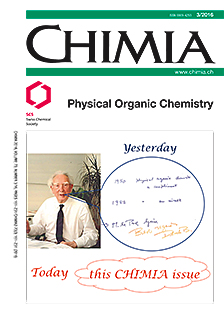Unusual Rearrangements of Radical Cations: The Role of Vibronic Coupling
DOI:
https://doi.org/10.2533/chimia.2016.164Keywords:
Radical cations, Vibronic couplingAbstract
Radicalcations often undergo very unexpected rearrangements. Three examples of such rearrangements are given, and it is shown how vibronic coupling between the ground and low-lying excited states may cause certain bonds that are quite solid in the neutral molecules to become so weak that they break spontaneously, even though the bond order does not change (or changes very little) on ionization. In radical cations where spin and charge are delocalized over two similar halves, vibronic coupling can lead to localization of spin and charge, which may greatly affect the reactivity. Finally, it is shown how vibronic coupling can lead to avoidance of state crossings, a feature that appears very frequently in rearrangements of radical cations.Downloads
Published
2016-03-30
Issue
Section
Scientific Articles
License
Copyright (c) 2016 Swiss Chemical Society

This work is licensed under a Creative Commons Attribution-NonCommercial 4.0 International License.
How to Cite
[1]
Chimia 2016, 70, 164, DOI: 10.2533/chimia.2016.164.







